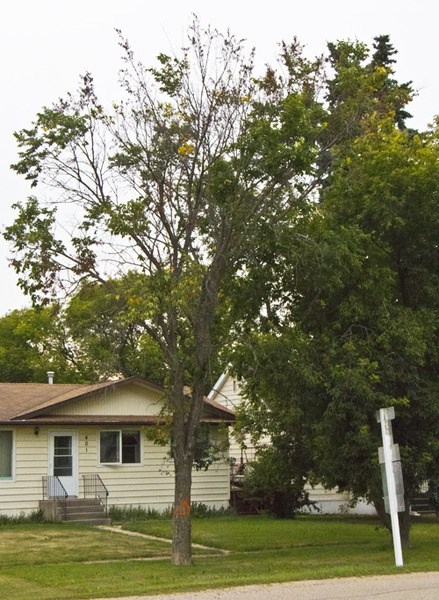For years before World War I, Europe was struggling with a different problem: elm trees were dying. It wasn't until 1921 when Bea Schwartz of the Netherlands discovered that this was a result of a fungus preventing the absorption of water: Dutch Elm Disease.
In 193,1 a company in the United States unknowingly brought infected logs from France, which caused a spread of the fungus in North America. Fifty years later the spread of Dutch Elm Disease reached Saskatchewan, and today we are still losing elm trees due to the fungus because there is no cure.
Each August, the towns in the surrounding area have trees checked for the disease. Recently, the Town of Arcola has found confirmed cases. When The Observer contacted the Town of Carlyle, the town was still waiting on a company to check for the diseased trees; though they've dealt with Dutch Elm Disease in the past.
Dutch Elm Disease is caused by a fungus, which is transported from elm tree to elm tree, usually by a beetle. The fungus then clogs the water system within the elm tree preventing movement of water and nutrients. As a result, the tree will wilt and die as it is unable to take in the moisture it needs to grow.
If the trees become infected earlier in the year, their branches and leaves will wilt, then turn brown. Typically, these leaves remain on the tree. If the tree is infected later in the year, the leaves will turn colour and drop prematurely. Symptoms of tree infected late in the summer can be mistaken for seasonal changes, but tests can be done on the sapwood to determine if the tree has Dutch Elm disease.
The fungus is spread in numerous ways including beetles (the most common), transporting infected firewood, and from tree to tree, if they are relatively close to each other through grafted or touching roots.
The Province of Saskatchewan has measures in place to prevent the spreading of the disease. These include a ban on pruning elm trees between April 1 and Aug. 31. However, there is no cure for ridding the tree of the fungus, which means the only way to eliminate Dutch Elm Disease is to destroy the infected trees in a timely manner. If the disease is identified during the pruning ban, it is still best to destroy the tree as soon as possible.
In Arcola, Dr. Tree Service hasconfirmed numerous trees this year after Bill Slykhuis brought his concerns to the town.BNA Holdings of Arcola will be removing those ontown property.
Speaking with Christie Peddie, the Town of Arcola Chief Administrative Officer, numerous infected trees have been found on both town land and on private property. Although the town wishes it could remove all of the trees for the residents, it won't be able to; but it does encourage residents to consider the seriousness of Dutch Elm Disease.
?It has hit Arcola really hard this year and I know it is quite an expense, it's really unfortunate, but the trees need to come down and the stumps removed,? Peddie explained. ?Sadly, the town can't pay for all of the trees infected to come down. I wish we could, but the town has had to deal with quite a few unexpected expenses this year from frozen water lines this spring, to our problems with the water treatment plant.?
The Town of Arcola will be spraying healthy Elm trees with pesticide to eliminate the numbers of beetles which carry the fungus as a way to try and prevent further spreading of Dutch Elm Disease. This, however, is not a perfect solution because the beetles help transmit the fungus from tree to tree, but if an infected elm tree is near another elm tree, the fungus can be spread through the root system.
?We will spray, but the diseased trees still need to go or else they can infect healthy trees with the fungus,? Peddie went on to say.
Though the Town of Carlyle's inspection hasn't been completed yet, last year, four trees were cut down and disposed of, which is the most they have had in a number of years, usually only seeing one or two trees infected, while some years there have been none affected.
?We have experts inspect the trees,? Huguette Lutz, Carlyle Chief Administrative Officer, explained. ?They look at the elms every year and if any are found they are cut down immediately, removed, and burned separately from anything else.?
?We've had some years with zero trees found with Dutch Elm Disease, but the reason we inspect every year is because if you don't, it can spread from tree to tree.?
It is essential the trees are removed to prevent the further spread of Dutch Elm disease and to save the remaining healthy elm trees. Prevention comes down to removing any infected specimens and the for owners of healthy elm trees to take care of them diligently.
Pruning healthy trees with dying branches before the provincial ban between April 1st and Aug. 31st is in effect because the native elm bark beetle is attracted to freshly-cut elm. Regular watering and fertilization can also help keep elm trees healthy.
Some infected trees can be pruned to stop the fungus from spreading, but this depends greatly on when the disease is identified and where the infection point was.
Registered fungicides can also save some elm trees, but even though these may prevent the disease, they can be costly and have to be reapplied every one to three years.




